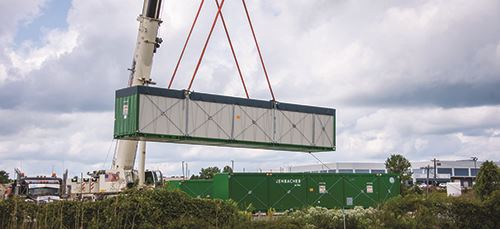Pittsburgh International Airport (PIT) made history in June when it flipped the switch on its own natural gas and solar energy powered microgrid. In an era when energy resiliency and independence have become a Holy Grail of sorts, PIT is the first airport in the world to be completely powered by its own microgrid. And, it did so at no cost to the airport or local taxpayers.
A microgrid is an independent electricity source that can operate autonomously while typically maintaining a connection to the traditional local grid. The version at PIT includes five natural gas-fired generators capable of producing 20 megawatts of electricity plus nearly 10,000 solar panels that can produce another 3 megawatts.
Currently, the airport’s peak demand is 14 megawatts, and the new on-site microgrid powers all of its landside and airside terminals, as well as the commuter tram, airfield, hangars, a Hyatt hotel and gas station. As a backup, PIT remains connected to the Duquesne Light electrical grid for emergency power.
|
Project: Onsite Microgrid Location: Pittsburgh Int’l Airport Cost: $30 million 100% Funding: Peoples Natural Gas Co. Total Capacity: 23 megawatts Key Elements: 5 natural gas-fueled generators capable of producing 20 megawatts; nearly 10,000 solar panels that can produce 3 megawatts
Airport’s Current Peak Demand: Microgrid Operator: IMG Energy Solutions Airport’s Engineering Consultant: Burns Engineering Requests for Qualifications/Proposals Issued: 2018
Development Contract Awarded: Developer/Owner: Peoples Natural Gas Co. Term: 20 years
Engineers: Lake Superior Consulting; Construction: June 2020-June 2021 General Contractors: PJ Dick
Concrete Trade Partner:
Natural Gas Generators:
Solar Field Design & Construction: Natural Gas: CNX Resources |
The $30 million project was completely financed by Peoples Natural Gas, which serves more than 750,000 homes and businesses in Pennsylvania, West Virginia and Kentucky. Because most construction occurred outside the airport’s FAA-secured area, contractors did not have to pass through security for construction activities.
Natural Resources
While airport officials hope this project can serve as an example for the industry, they also recognize it would be difficult to duplicate because few other airports enjoy PIT’s confluence of natural assets. Namely, it has ample real estate that sits atop the Marcellus Shale, a natural gas reserve that runs under parts of Pennsylvania and five other states. With 8,800 acres, PIT is one of the 10 largest airports in the U.S.
The recent microgrid project is not PIT’s first foray into tapping the natural gas of the Marcellus Shale. In 2013, the airport struck a deal with Consol Energy (now CNX Resources) to develop natural gas wells on its property. PIT signed a 20-year agreement with CNX that includes royalty payments to the airport on gas that comes from the ground, and the company has operated more than a dozen wells there ever since.
The contract with Peoples Natural Gas to own, finance, maintain and operate the new microgrid is also a 20-year agreement. It entitles PIT to purchase power generated by the microgrid at a below-market rate, and Peoples Natural Gas is allowed to sell the excess power on the wholesale market. Purchasing its power from the microgrid is estimated to save the airport $500,000 in the first year alone, notes Tom Woodrow, PIT’s vice president of Engineering.

The airport also collects a nominal ground lease fee for the land the microgrid occupies. After its current 20-year agreement expires, PIT has the option to sign a new contract with Peoples Natural Gas, or find a different company to operate the microgrid.
“Pittsburgh International Airport is now one of the most site-hardened [energy-resilient] public facilities in the world, while at the same time becoming more sustainable,” PIT Chief Executive Officer Christina Cassotis told the airport’s news service, Blue Sky News. “That’s a tribute to the innovative culture of our team, and we hope this project can be a model across the industry.”
4 Key Objectives
The airport worked with Burns Engineering’s Pittsburgh office to issue a request for qualifications and a request for proposals for the microgrid project in 2018. The four primary goals of the project were:
- increasing power reliability and resilience
- supporting PIT’s sustainability goals
- lowering electricity costs for the Allegheny County Airport Authority and PIT tenants
- supporting the local natural gas industry

Airports around the world share PIT’s goal of increased energy reliability and resilience, as loss of electrical power causes disruptive and expensive standstills. An 11-hour power outage at Atlanta Hartsfield-Jackson Airport (ATL) in December 2017 threw air travel throughout the U.S. into disarray. Delta Air Lines alone had to cancel 1,400 flights during the outage. This year, power outages have already affected McCarran International in Las Vegas (LAS), Denver International (DEN) and Los Angeles International (LAX).
 David Smith, director of Energy Services at Burns Engineering, notes that PIT initiated discussions with his company about developing a microgrid before the ATL outage occurred. But that event accelerated officials’ desire to become more energy resilient. “When Atlanta happened, that’s what reinforced the decision to proceed with some urgency and determination,” Smith recalls. “They were already looking to go this direction, but Atlanta sealed the deal.”
David Smith, director of Energy Services at Burns Engineering, notes that PIT initiated discussions with his company about developing a microgrid before the ATL outage occurred. But that event accelerated officials’ desire to become more energy resilient. “When Atlanta happened, that’s what reinforced the decision to proceed with some urgency and determination,” Smith recalls. “They were already looking to go this direction, but Atlanta sealed the deal.”
Airports throughout the world are reviewing options to enhance energy and power resilience as they shift away from fossil fuels and transition toward electric ground service vehicles and other equipment, Smith adds.
“As more and more systems are electrified, you become increasingly dependent on reliable and resilient power, therefore a general trend is emerging to build in resilience as you electrify,” he explains. “On top of that, you have more frequent extreme weather and other new threats like cyber terrorism that are reinforcing concerns about the grid.”
Other U.S. airports that have installed microgrids in recent years or that plan to install one include Detroit Metropolitan Wayne County Airport (DTW), John F. Kennedy International Airport (JFK) in New York City, San Diego International Airport (SAN), Chattanooga Metropolitan Airport (CHA) and California Redwood Coast-Humboldt County Airport (ACV).
The microgrid at PIT connects to the traditional power grid but can operate independently—what is known as “island mode.” It is noteworthy, however, because it powers the entire airport and related facilities.
 When the airport began looking for a partner to develop its microgrid, officials purposely left the specific design parameters wide open. “We let them propose any combination of technologies they wanted to meet the goals we identified,” Woodrow explains. A group of 16 companies responded to PIT’s request for qualifications, and the project team invited eight to submit proposals. Peoples Natural Gas was ultimately selected with a plan for a microgrid that would supply 100% of the airport’s electrical needs and meet all the goals of the project.
When the airport began looking for a partner to develop its microgrid, officials purposely left the specific design parameters wide open. “We let them propose any combination of technologies they wanted to meet the goals we identified,” Woodrow explains. A group of 16 companies responded to PIT’s request for qualifications, and the project team invited eight to submit proposals. Peoples Natural Gas was ultimately selected with a plan for a microgrid that would supply 100% of the airport’s electrical needs and meet all the goals of the project.
Innovative Arrangement
In October 2019, the Allegheny County Airport Authority awarded Peoples Natural Gas a 20-year contract to build, maintain and operate a microgrid at PIT. Construction started in June 2020 and lasted about one year.
Peoples Natural Gas subcontracted IMG Energy Solutions to provide the drawings that served as the basis for the natural gas generation plant and to operate it. IMG also constructed and now owns and operates the solar component of the project. The unique structure of PIT leasing land to a utility company to build and operate a microgrid that powers the airport has been dubbed microgrid-as-a-service.

 “Typically, infrastructure like this would be owned by the customer, not the utility,” explains Jeff Nehr, vice president of business development at Peoples Natural Gas. “But we’re trying to make the point that these are projects that are possible, feasible and economical. If it can offer cost savings along with resiliency, it’s a good option for airports.”
“Typically, infrastructure like this would be owned by the customer, not the utility,” explains Jeff Nehr, vice president of business development at Peoples Natural Gas. “But we’re trying to make the point that these are projects that are possible, feasible and economical. If it can offer cost savings along with resiliency, it’s a good option for airports.”
Looking ahead, PIT’s management team and airport authority officials are bullish about development opportunities for more than 3,000 acres of airport land. Low-cost energy now available through the microgrid or a new microgrid would be an attractive perk for tenants at a business park, should one be developed.
“Our region has innovation in its DNA, and the construction of this microgrid reflects the work that has been done at the airport to maximize public safety and sustainability,” says Allegheny County Executive Rich Fitzgerald. “I’m extremely proud that the airport is utilizing nearly 10,000 solar panels as a source of sustainable energy. It, along with the other mix of energy generated at the airport, continues to position this facility as an industry leader.”




